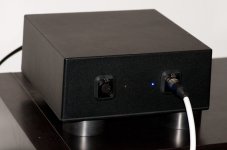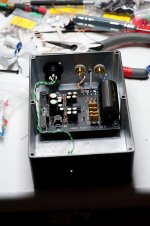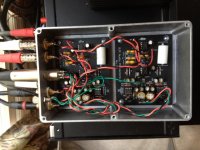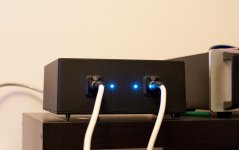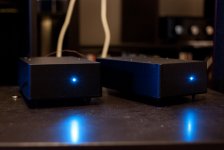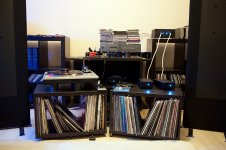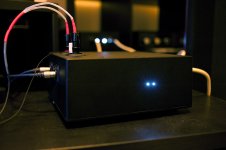Ronald's answer is absolutely correct. The problem though is this is essentially a one-way mod, since pulling out transistors and other X-reg components isn't something you can do repeatedly.
What I suggest instead is a second set of boards. Swapping boards in and out is relatively easy, and an X-reg-less phonoclone BOM cost is low.
For experimental purpose I removed the X-reg transistors from the Phonoclone PCB this afternoon without cutting the pins....that was really a pain in the ***!
Ronald.
Nice read. Makes a lot of sense, although I would love to learn a bit more about what the current spikes can cause.
Anyway, your simulation might be a bit optimistic too. You are forgetting about the big startup inrush current because of the empty filter caps, which on a very rough simulation on my pc started/peaked at about 12A and eventually balanced at about 1A spikes (with a similar but simpler circuit - just a resistor in parallel to the filter capacitors).
Reducing the filter cap size (to something like 100uF) caused the current spikes to be reduced to almost half, but the voltage ripple was quite bigger.
I guess it is a give-take situation...
The thing is that we can afford more current (bigger transformer/bridge) but bigger ripple is always a big problem, although smaller caps might be nice.
So QFT... do not cheap-out on transformer and rectifier specs...
Anyway, your simulation might be a bit optimistic too. You are forgetting about the big startup inrush current because of the empty filter caps, which on a very rough simulation on my pc started/peaked at about 12A and eventually balanced at about 1A spikes (with a similar but simpler circuit - just a resistor in parallel to the filter capacitors).
Reducing the filter cap size (to something like 100uF) caused the current spikes to be reduced to almost half, but the voltage ripple was quite bigger.
I guess it is a give-take situation...
The thing is that we can afford more current (bigger transformer/bridge) but bigger ripple is always a big problem, although smaller caps might be nice.
So QFT... do not cheap-out on transformer and rectifier specs...
Yes, my LT spice sim also shows over 10A on the first cycle - I cut out the start up ramp on the data I posted to the blog. Diodes and transformers are designed to handle inrush currents, within reason.
Reducing capacitance lowers the conduction angle and the ripple ratio, they are, as you observe, linked. Resistance (or inductance) breaks that link. The more series impedance on the power line, the lower the ripple voltage, the lower the inrush currents, and the lower the diode peak conductance. A little resistance in the form of a CRC filter goes a long way here.
Reducing capacitance lowers the conduction angle and the ripple ratio, they are, as you observe, linked. Resistance (or inductance) breaks that link. The more series impedance on the power line, the lower the ripple voltage, the lower the inrush currents, and the lower the diode peak conductance. A little resistance in the form of a CRC filter goes a long way here.
The mundorf capacitors were a nice opportunity to move into a full dual mono topology.
Their damn size was too big to fit in the case the way it was drilled (connectors were on the way), so I decided it was time to redo the case-work.
Here is a quick look on the new layout.
I did not hear it yet. I still have to work on the second channel and on the power supply.
I would like to hear the effect of the capacitors with the same power supply as well to see how they affect the sound, but anyway....
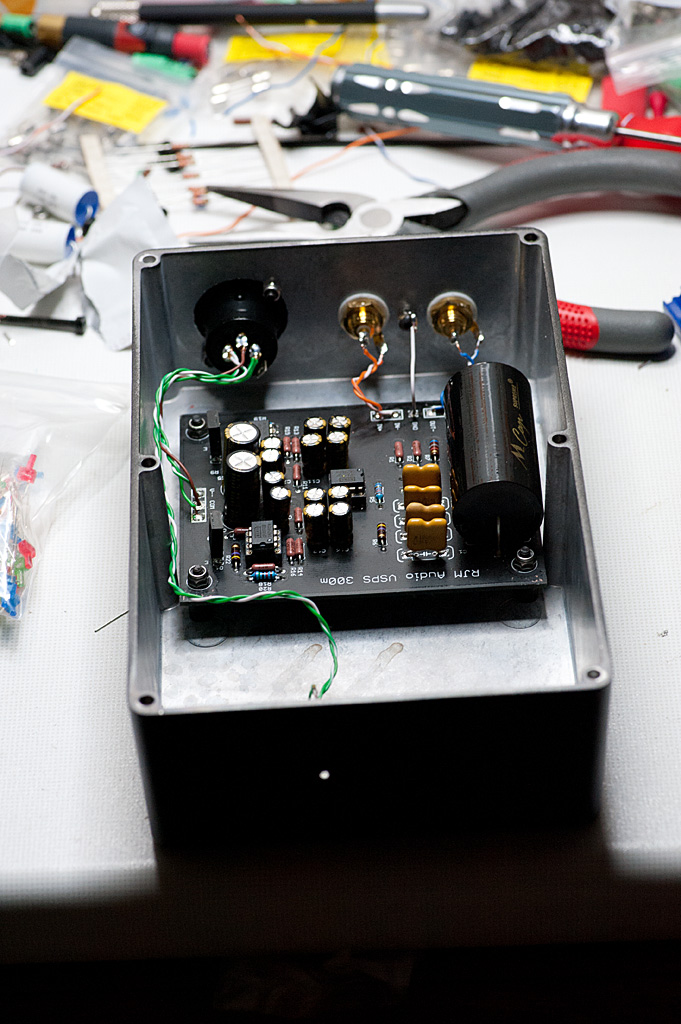
Their damn size was too big to fit in the case the way it was drilled (connectors were on the way), so I decided it was time to redo the case-work.
Here is a quick look on the new layout.
I did not hear it yet. I still have to work on the second channel and on the power supply.
I would like to hear the effect of the capacitors with the same power supply as well to see how they affect the sound, but anyway....
Attachments
Phonoclone finally done
After many struggles and mistakes, and with lots of help from RJM, members of this forum, my brother the electronics whiz, and lots of orders from Digikey, my Phonoclone3 is finally finished.
All I can say at this point is thank you, I could not have done it without all of you, and WOW, the sound is positively gorgeous.
John
After many struggles and mistakes, and with lots of help from RJM, members of this forum, my brother the electronics whiz, and lots of orders from Digikey, my Phonoclone3 is finally finished.
All I can say at this point is thank you, I could not have done it without all of you, and WOW, the sound is positively gorgeous.
John

An externally hosted image should be here but it was not working when we last tested it.
I just finished listening to some records after installing the Mundorf supremes and splitting the supply into two mono parts.
The only set-back was that I had to use the 120VA toroids since I do not have a second 160VA.
First thoughts is that the change was quite impressive (despite the smaller toroids). Stereo image is wider than ever, focus is amazing and micro-details are now flowing everywhere. It s almost spooky.
Unfortunately the problem with the mid-lows still persists, making the super detailed sound a bit tiresome (I should give the mundorfs a couple of weeks).
Oh and the two cases thing is a bit of a problem for grounding. I m getting some more hum than before, even with the internal wiring signifficantly shorter and cleaner.
I really should get a bigger single case and fit the two boards in there (still full dual mono, but single earth points).
I also ordered a Jelco HS-25 headshell so that I can fix my azimouth problem too.
Tomorrow I m also throwing a new mouser order for a second 160VA toroid, resistors to fix the voltage divider, Panasonic FR capacitors for the x-reg, new bigger case and neutrik RCA sockets. And I m pretty sure I am forgetting something...
The only set-back was that I had to use the 120VA toroids since I do not have a second 160VA.
First thoughts is that the change was quite impressive (despite the smaller toroids). Stereo image is wider than ever, focus is amazing and micro-details are now flowing everywhere. It s almost spooky.
Unfortunately the problem with the mid-lows still persists, making the super detailed sound a bit tiresome (I should give the mundorfs a couple of weeks).
Oh and the two cases thing is a bit of a problem for grounding. I m getting some more hum than before, even with the internal wiring signifficantly shorter and cleaner.
I really should get a bigger single case and fit the two boards in there (still full dual mono, but single earth points).
I also ordered a Jelco HS-25 headshell so that I can fix my azimouth problem too.
Tomorrow I m also throwing a new mouser order for a second 160VA toroid, resistors to fix the voltage divider, Panasonic FR capacitors for the x-reg, new bigger case and neutrik RCA sockets. And I m pretty sure I am forgetting something...
Phonoclone picture
Sorry the picture did not show up before.
First impressions:
Very quiet. Loads of detail. Punchy bass. Good imaging.
Glenn Gould, Goldberg Variations (1982): great attack and decay, lots of overtones, excellent dynamics.
Donald Fagen, The Nightfly: lots of punch, vocals are rich and detailed, drums have lots of snap, bass is clear and distinct.
Stray Cats: Built for Speed: Not a great recording. Sounds a little harsh.
Ry Cooder: Jazz: Nice detail and balance. The tuba actually sounds like a tuba. You can feel the Ry's aggressive finger picking.
I have been a little disappointed with the sound of the Clearaudio Concept table with the Clearaudio MC cartridge through my Project Phonobox SE. Not anymore. The Clearaudio really shines with the Phonoclone.
John
Sorry the picture did not show up before.
First impressions:
Very quiet. Loads of detail. Punchy bass. Good imaging.
Glenn Gould, Goldberg Variations (1982): great attack and decay, lots of overtones, excellent dynamics.
Donald Fagen, The Nightfly: lots of punch, vocals are rich and detailed, drums have lots of snap, bass is clear and distinct.
Stray Cats: Built for Speed: Not a great recording. Sounds a little harsh.
Ry Cooder: Jazz: Nice detail and balance. The tuba actually sounds like a tuba. You can feel the Ry's aggressive finger picking.
I have been a little disappointed with the sound of the Clearaudio Concept table with the Clearaudio MC cartridge through my Project Phonobox SE. Not anymore. The Clearaudio really shines with the Phonoclone.
John
Attachments
I have been a little disappointed with the sound of the Clearaudio Concept table with the Clearaudio MC cartridge through my Project Phonobox SE.
Color me not surprised. Well, good that things improved, and you got your PC3 up and running. It looks very nice, by the way. The power cable placement is a little unfortunate, but with such a small enclosure it can't be helped.
/R
I am not getting any hum or artifacts that I can notice, so the proximity of the power wiring to the output wires does not seem to be a problem.
I will change to a bigger case when I assemble the B-boards.
Next up is a pair of the Manzanita OB speakers and a couple of power supplies for my Squeezebox and rDac to replace the wall worts.
I will change to a bigger case when I assemble the B-boards.
Next up is a pair of the Manzanita OB speakers and a couple of power supplies for my Squeezebox and rDac to replace the wall worts.
One week further into breaking in, and things finally seem to have fallen in place.
The VSPS 300 with the Mundorfs has finally shown its teeth. The Nichicon electrolytics required about 100 hours of breaking in. At the moment I do not feel the urge to change anything, as it simply surpasses any phono I have tried (including some that worth a few thousand euros).
The only changes that I will try (mostly because I have already ordered the parts) is to fiddle with the X-Reg divider to give 10V to the op-amps, a single big case with single grounding points and better wiring arrangement with pure silver wire to further reduce the minor humm that still remains (probably from my 3f tonearm cable) and finally replace the 120VA toroids with 160VAs again. Oh and I want to replace the umblicals with something... nicer than the plain power cable...
This building experience has been a real eye opener about the design and quality of some so called high-end devices...
Oh and the phono is a perfect match for the LightSpeed passive preamp.
And here is some porn because I know you like seeing stuff (leds are white not blue... damn white balance...)
(leds are white not blue... damn white balance...)
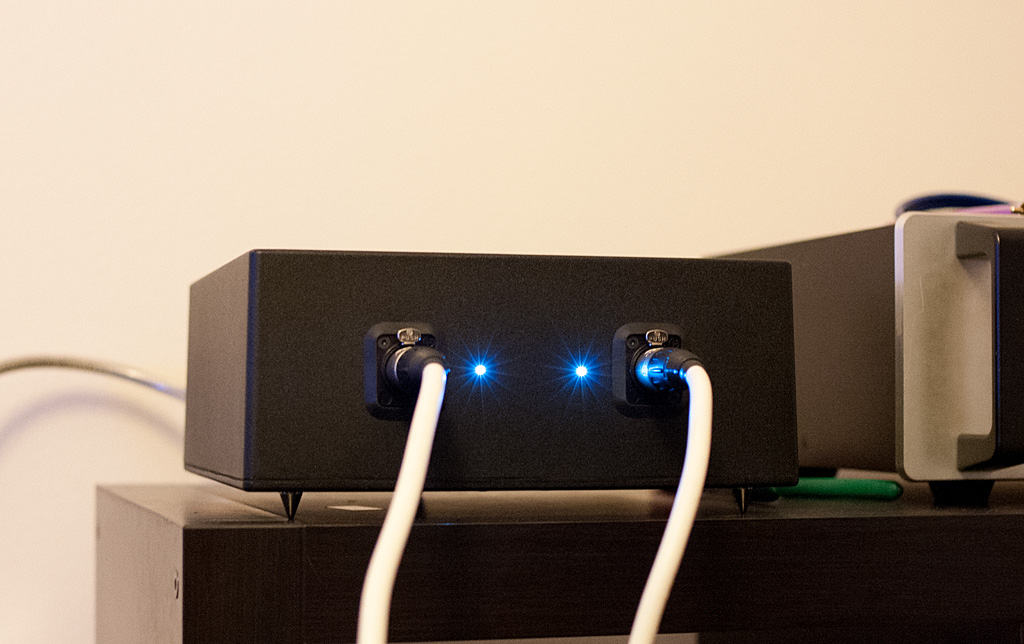
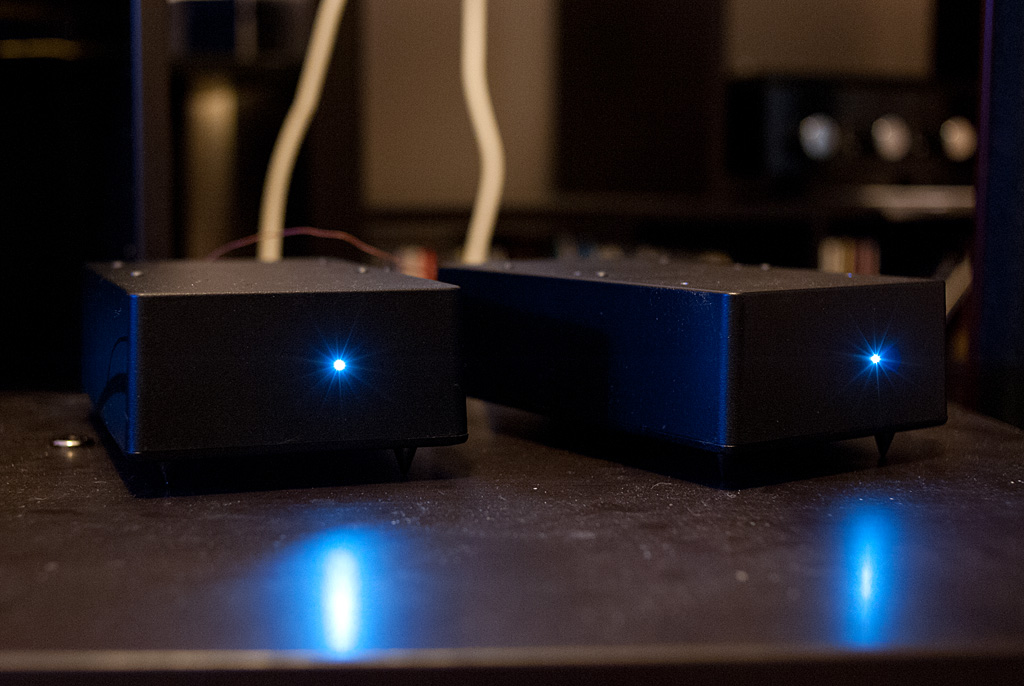
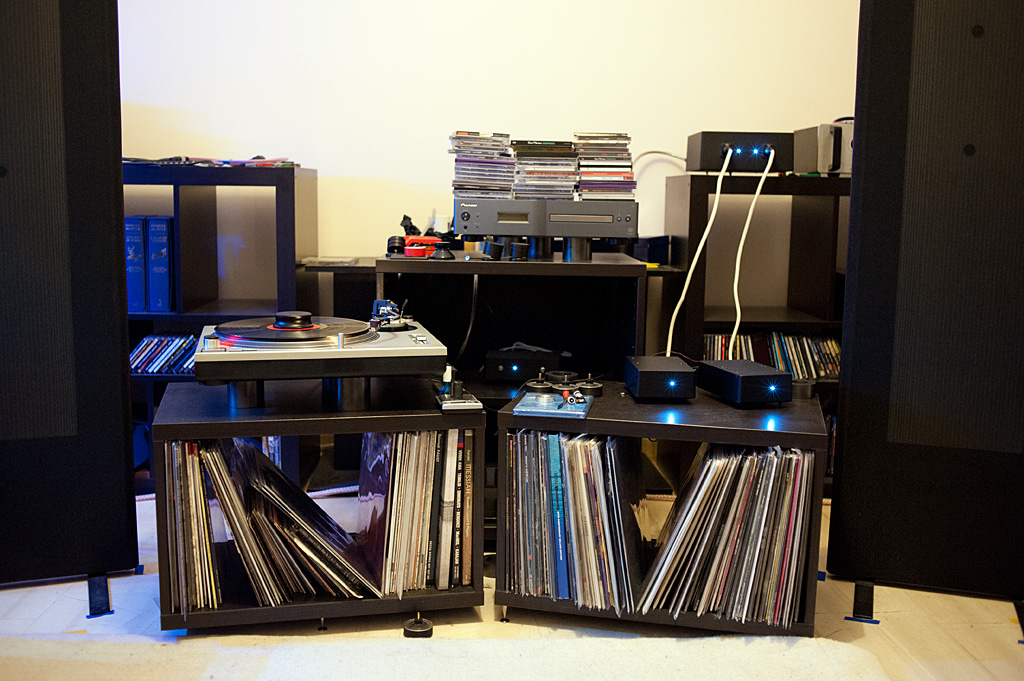
The VSPS 300 with the Mundorfs has finally shown its teeth. The Nichicon electrolytics required about 100 hours of breaking in. At the moment I do not feel the urge to change anything, as it simply surpasses any phono I have tried (including some that worth a few thousand euros).
The only changes that I will try (mostly because I have already ordered the parts) is to fiddle with the X-Reg divider to give 10V to the op-amps, a single big case with single grounding points and better wiring arrangement with pure silver wire to further reduce the minor humm that still remains (probably from my 3f tonearm cable) and finally replace the 120VA toroids with 160VAs again. Oh and I want to replace the umblicals with something... nicer than the plain power cable...
This building experience has been a real eye opener about the design and quality of some so called high-end devices...
Oh and the phono is a perfect match for the LightSpeed passive preamp.
And here is some porn because I know you like seeing stuff
Attachments
Fun fact: White LEDs are blue, the camera is being more honest than your eyes. There's a phosphor in front to convert the blue light to longer wavelengths, so the total output looks white, but there is still a strong blue bias, especially around the edges where more of the original blue light leaks out around the phosphor.
Hehe yes those damn thingies have a bluish tint anyway. But still there should be no "camera being more honest than the eyes"... A camera should be honest to what the eye sees... anyway, it s hard to balance the colors even manually when you have 3 different light sources with different tints (tungsten ceiling bulb, actinic blue from aquarium and fluorescent green from desk light)
Yesteday I moved everything into a big single case with clearer cable topology with power, input and output on completely different sides of the case and nice big Neutrik sockets for everything.
Unfortunately it was late when I finished and could not test it on proper listening volumes, but a first impression from low volumes was that it has cleaned up a bit, although bass seemed a bit leaner (could be the new cabling).
Today I will also replace the 120VA toroids with the 160VA ones, and that will be all for now...
Going to work on my turntable next.
Yesteday I moved everything into a big single case with clearer cable topology with power, input and output on completely different sides of the case and nice big Neutrik sockets for everything.
Unfortunately it was late when I finished and could not test it on proper listening volumes, but a first impression from low volumes was that it has cleaned up a bit, although bass seemed a bit leaner (could be the new cabling).
Today I will also replace the 120VA toroids with the 160VA ones, and that will be all for now...
Going to work on my turntable next.
OK done with modifications for now. 160VA toroids are installed.
Whoever still doubts the "big toroid" advise, I have just one sentence for you.
JUST DO IT... In capitals... as in DO IT NOW...
The dual 160VAs gave so much body to the music (on all frequencies) it is unbelievable. The difference from the 120VA when I used only one toroid and still had the vishay MKPs on was not so big. With the Mundorfs and full dual mono topology, the difference is insane.
And here is a photo of my final chassis (no white balance this time, so that you can see the white leds properly ).
).
Might seem a bit weird, but it was well thought of. All cables are far away from each other. Input is on the top to allow the cable to "float" away from all other ones while coming straight from the tonearm (still have work on that area).
The output is on the left side, while the power input is on the right. This besides from keeping them away from each other, will also allow for easy plugging/unplugging when I move it to its permanent place. Not very WAF friendly, but meh...

Whoever still doubts the "big toroid" advise, I have just one sentence for you.
JUST DO IT... In capitals... as in DO IT NOW...
The dual 160VAs gave so much body to the music (on all frequencies) it is unbelievable. The difference from the 120VA when I used only one toroid and still had the vishay MKPs on was not so big. With the Mundorfs and full dual mono topology, the difference is insane.
And here is a photo of my final chassis (no white balance this time, so that you can see the white leds properly
Might seem a bit weird, but it was well thought of. All cables are far away from each other. Input is on the top to allow the cable to "float" away from all other ones while coming straight from the tonearm (still have work on that area).
The output is on the left side, while the power input is on the right. This besides from keeping them away from each other, will also allow for easy plugging/unplugging when I move it to its permanent place. Not very WAF friendly, but meh...
Attachments
Can anyone help, please.
Hi everybody.
I'm Darrell a newbie, nice to be here.
I do however have a small problem. I have built a pair of Phonoclone 3 boards and strangely they sound quite 2 dimensional, mono it you like.
I suspect it my bypass caps but would like to be sure before changing anything.
They are Elna Silmic II.
I know they can over smooth in the signal path, can they do thins in the bypass position, or am I barking up the wrong tree?
Thanks in advance.
Daz.
Hi everybody.
I'm Darrell a newbie, nice to be here.
I do however have a small problem. I have built a pair of Phonoclone 3 boards and strangely they sound quite 2 dimensional, mono it you like.
I suspect it my bypass caps but would like to be sure before changing anything.
They are Elna Silmic II.
I know they can over smooth in the signal path, can they do thins in the bypass position, or am I barking up the wrong tree?
Thanks in advance.
Daz.
- Home
- Source & Line
- Analogue Source
- The Phonoclone and VSPS PCB Help Desk
